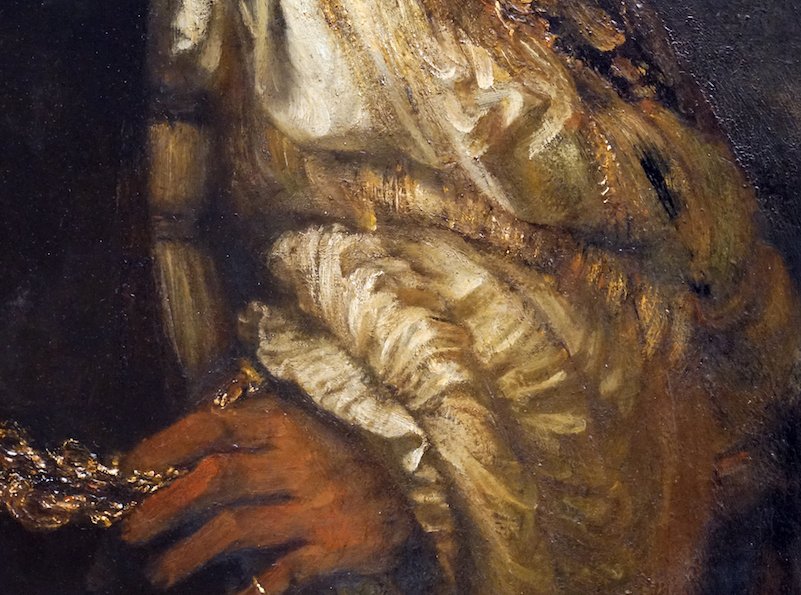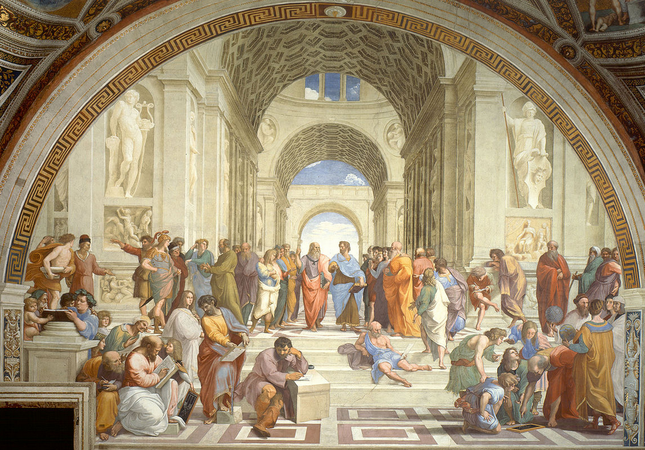 |
| Aristotle with a Bust of Homer (1653 Rembrandt) |
From the renaissance period we receive the naturalistic and idealization of humans and their lives. The classical antiquities worldly divine powers reaching down through the artists and painting it into the canvas, sculptures, and music. The prominence of characteristics such serenity, beauty, and religious distinction is indicative of the divine powers connection to the 'human' experience.
Unlike that of the Renaissance period, the the Baroque period throws out this divine connection and the idealizing of the human experience. The Baroque era is a period of artistic representation expressing drama, realistic, and intense artistic forms. In a mere century the Baroque era of artistic development pushes out the Renaissance and likewise the Renaissance pushes out the Middle Ages.
Barocco as described in the lecture in Portuguese is an irregularly shaped pear, the way I see it the Baroque which was defined later on is a half eaten fruit. One can consider the dilemma of the 'glass half full' or the 'glass half empty'. I think the Baroque is a period of one realizing that the natural world filled with beauty contains just a bit of darkness. One can pull back briefly and consider the up's and down's of the artistic movement shifts. From the dark ages we follow it with the light of the Renaissance and then immediately after we once again go down towards the darkness of the Baroque era.
Appreciation of "Aristotle with a Bust of Homer":
Aristotle defines two functions as superior in human beings 'touch' and 'sight'. Rembrandt depicts these two key functions both directly and indirectly in the 1653 quintessential Rembrandt Baroque piece that is currently located in the New York Metropolitan Museum. Painted approximately in 1653 in Leiden, Netherlands.
This painting is unique in that it takes two literary and philosophical icons of Aristotle and Homer who are represented in this Baroque art piece by Rembrandt. The reason for my selection of this piece was my initial curiosity with this prestigious and lamentable scene of Aristotle placing a hand on Homer's bust, looking out with a soulful look into the unknown, all the while wearing and clutching on to the glory of gold and his prestigious career.
These Baroque aesthetics that are indicative of the artistic era can be distinctly seen in a few parts of the painting: 1) Tenebrism, 2) Realism, and 3) Dramatization
Firstly, regarding Tenebrism. Tenebrism which is dramatic illumination used by the artistic technique of chiaroscuro. As seen in the image referenced below, one can see the darkness of the background surrounding Aristotle and the Bust of Homer. The darkness of the clothing in correlation to the gold colored frame of this painting located in the NY Met (New York Metropolitan Museum). One can see the other Baroque paintings featured next to Rembrandt one all have the same 'tenebrism' effect of illuminating the figures just slightly all the while containing the dark tone where Aristotle and the bust of Homer are being swallowed by the darkness.
 |
| Located in Metropolitan Museum in New York - Aristotle with a Bust of Homer (1653) |
Secondly, there is realism. The realistic components of the piece make it extremely understandable and relatable in that. Aristotle who in the painting by Rembrandt is wearing a golden chain, symbolic of the prestige and wealth of status he has gained over time is debating with himself on the value of the material wealth he has in comparison to the legacy that Homer has on the world. Aristotle is wondering the significance of his existence which brings a real sense. Furthermore, if one looks at the gold chain, clothing, and set up of the painting one can consider Rembrandt to be recognizably similar to a king (I am here expressing those of Alexander the Great and Julius Caesar). The hand gesture motioning towards the medallion which like that actually of Alexander the Great shows the real issues that Aristotle is realistically questioning. Between the period of Homer's greatness and now Aristotle's greatness, Aristotle wonders if he will ever be as Homer once was or will be remembered as.
 |
| Rembrandt uses a sort of characteristic of the Baroque era in which Aristotle is grasping onto a material reality and struggling greatly instead by grasping only a part of his wealth. |
Thirdly, dramatization. This component of the Baroque era is extremely realistic and indicative of the down-to-earth sentiment of the Rembrandt painting. One can look at the facial expression of Aristotle 'soulful' in many ways. Worried about the future, reminiscing about the past, and pondering his existence currently. If you look into eyes you can feel the foreshortening effect of being pulled into his thoughts of existence. You can see the age gaining on Aristotle at this later point in his life where the wrinkles show experience of life, but at the same time also a sort of exhaustion.
 |
| Raphael, School of Athens, 1509-511 |
Sources:
Metmuseum.org, www.metmuseum.org/art/collection/search/437394.
“Rembrandt, Aristotle with a Bust of Homer (Article).” Khan Academy, Khan Academy, www.khanacademy.org/humanities/renaissance-reformation/baroque-art1/holland/a/rembrandt-aristotle-with-a-bust-of-homer.
“School of Athens by Raphael (Article).” Khan Academy, Khan Academy, www.khanacademy.org/humanities/ap-art-history/early-europe-and-colonial-americas/renaissance-art-europe-ap/a/raphael-school-of-athens.
Image Sources:
- https://www.khanacademy.org/humanities/renaissance-reformation/baroque-art1/holland/a/rembrandt-aristotle-with-a-bust-of-homer
- https://www.metmuseum.org/art/collection/search/437394
- https://www.khanacademy.org/humanities/ap-art-history/early-europe-and-colonial-americas/renaissance-art-europe-ap/a/raphael-school-of-athens


Comments
Post a Comment